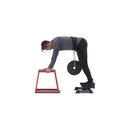The calves comprise two major parts, with names that sound like a Roman emperor:
1. Soleus: A wide, flat muscle located on the tibia and fibula. The soleus plays an important role in maintaining standing posture. If not for its constant pull, you'd tip over faster than a drunk on an ice rink. Lying deep under the overlapping gastrocnemius, the soleus is only visible from the sides of the lower leg.
2. Gastrocnemius: Large muscles located near the middle of the lower leg and goes to the top of the fibula and tibia. The gastrocnemius is broken down into two smaller groups: the medial head (inner calve) and the lateral head (outer calve). Its primary function is plantar flexing the foot at the ankle joint and flexing the leg at the knee joint.
Those muscles wrapped around your shin are a mystery wrapped in an enigma when it comes to training. Do they grow according to genetics or training stimulus? And if training does make all the difference, what kind of training are we talking about? Heavy weight for low reps, or lighter weight for high reps?
Power-walking soccer moms would sport monster calves if repetitive motion were the key. You need to hit 'em hard.
Arnold, who ruined the elastic in his fair share of tube socks in the 70s, put it this way: "Every day you walk around. When you walk you are using your calves. You are pushing at least your body weight every time you take a step. So, when you go to the gym and work out your calves with light weight, are you really stressing your muscles?"
Arnold put his calves through the ringer. He would perform all types of calf raises until he couldn't fully extend the muscle. Then, he would perform little bursts until the muscle finally couldn't move or extend, rendering his foot practically useless at the time after training. This method contributed to him becoming arguably the greatest bodybuilder of all time.
I take a similarly aggressive approach to raising calves. Your calves will not grow unless you absolutely DESTROY them! So I'm going to ask you to tack 10-to-12 sets of calf work onto the end of 4 or 5 workouts a week. (If that's too many sets at first, start at 5 and then build up to 12.) Each set should be 30 reps: 10 reps with toes pointed out, 10 reps with toes pointed in, 10 reps with toes pointed forward. No matter what calf move you're doing, switch it up like this.
The calves need this smack-down. Their strength should be commensurate with the strength of your quads and hamstrings. A weak link between your bigger legs muscles and the ground will limit performance and perhaps cause injury.

BodyFit
$6.99/month- 2,500+ expert-created single workouts
- 3,500+ how-to exercise videos
- Detailed workout instruction
- Step-by-step workout tips
- Training at gym or at home
- Access to Workout Plans
- Access to Bodyfit App
- Store Discounts
Already have a Bodybuilding.com account with BodyFit? Sign In

What comes with BodyFit?

- Instructional Videos
Don't risk doing a workout improperly! Avoid injury and keep your form in check with in-depth instructional videos.

- How-to Images
View our enormous library of workout photos and see exactly how each exercise should be done before you give it a shot.

- Step-by-Step Instructions
Quickly read through our step-by-step directions to ensure you're doing each workout correctly the first time, every time.
Exercise 1 (gastrocnemius)
Donkey Calf Raise
Donkey calf raises are my favorite exercise. Unfortunately, most gyms don't have a machine to help with progression. If that's the case, you might just have to throw some babes (or dudes) on your back like Arnold displayed on "Pumping Iron."
These can be performed with or without weight, but remember, weight builds size. It depends on your pain threshold. Simply bend over and support yourself on a bench and have your training partner or a random person get on your back. Raise your heels off the floor, pause at the top of the muscle contraction, return your heels down, almost touching the floor, and repeat.
If it's too easy for you, the person on your back can hold dumbbells or a barbell to add weight.
Exercise 2 (gastrocnemius)
Standing Calf Raise
Standing calf raises usually require less weight, depending on how much your back can handle. They can be performed in three ways:
Using a Smith Machine
With a barbell on your back
On one leg with a dumbbell in the opposite hand, using your free hand as support
Using a Smith Machine is the most common because the lifter does not need to stabilize the bar on their back while performing the exercise.
You can throw in different variations by using one leg or by pausing at the top of the contraction for a length of time.
Exercise 3 (soleus)
Seated Calf Raise
Seated calf raises are most commonly performed using a machine where you sit and a padded section rests on top of your knees. Unlike standing calf raises, this allows your legs to be at a 90-degree angle, putting most of the emphasis on the soleus.
Performing this exercise without a machine is a task, but is possible. Start by sitting on a bench and put a barbell on your knees with feet shoulder-width apart. Raise your heels off the ground, pause at the top of the muscle contraction, then return your heels down, almost touching the floor, and repeat.
Exercise 4 (soleus and gastrocnemius)
Calf Raise On Leg Press
I love doing calves on the leg press machine. Make sure to stretch well through the medial and lateral side of the leg between sets and before and after the exercise. Try it with your knees locked and slightly bent. Some people struggle or feel pain with locked knees.
The beauty of using this machine is that you can place your feet in so many ways. Try doing one leg at a time if that works best for you. Be sure to fully extend through your toes at the top of the motion, squeezing and concentrating the calves. Don't let the soleus muscle do all of the work!




